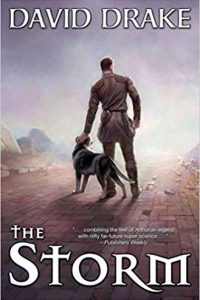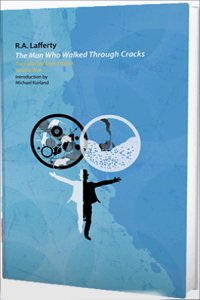Paul Di Filippo reviews Jay Lake
“What can you say about a twenty-five-year-old girl who died?”
Please forgive my appropriation of the infamous opening line to Erich Segal’s Love Story. But Jay Lake’s grief-fraught, premature death at age forty-nine, with its salient elements of archetypical and heroic struggle, naturally prompts one to think of similar epic demises, both fictional and historical. The roll call of authors who died too young—Chatterton, Keats, Kafka, Charles Beaumont, Tom Reamy—is a long and illustrious one. But something about Lake’s highly public social-media passage through his illness and out of this life recalled to me that cinematic analogue, with its capacity to affect millions of “viewers.” And of course, such an extra-literary ambiance can skew any estimation or appreciation of his actual fiction. So, looking at this posthumous volume, what might very well be Lake’s last book (a third volume in The City Imperishable series, Reign of Flowers, was long rumored, but seems in this collection to be denied by Lake himself), it behooves us, having acknowledged up front the tragic circumstances of his life, to honor him by evaluating the stories strictly on their own merits.
This volume contains over thirty stories, published from 2007 to 2013, so there is assuredly little overlap with Lake’s earlier collections. In other words, we are getting his mature work, written almost precisely in the interstices of his illness, which began in 2008. I can’t do an exegesis of each and every tale in this space, so I’ll hit the highlights. But you can rest assured that every piece is accomplished and rewarding, a miracle considering the stresses Lake endured.
Launching the book is a vibrant and touching and sympathetically hard-nosed introduction by Gene Wolfe. To appreciate its resonance, read the concluding “Afterword.” And you might jump ahead to “The Cancer Catechism” too while you’re at it.
Putting the title story first, by itself, is a smart move, as it shows Lake’s bravura prowess. Starting out as pure Neal-Stephenson-style thriller, with tough guy mercs in Mongolia, it segues into magical realism in a beautiful fashion.
The rest of the stories are arranged into thematic sections, and this setup showcases Lake’s vast spectrum of styles and sensibilities.
First comes the hardcore science fiction stuff, under the rubric “Science and Other Fictions.” Lake exhibits total mastery of that suite of tropes. With a nod to Heinlein, “Permanent Fatal Errors” revels in a ship of posthumans studying odd phenomena around a brown dwarf star. “‘Hello,’ Said the Gun” is a short-short (not an easy category to master) that brings a sentient weapon face-to-face with a naïve human. And “West to East” is an example of clever worldbuilding—the adventures of some humans in the ecosystem of a planet with “superrotating atmosphere”—that Hal Clement would have been proud to write.
The next section is titled “Steam, Punks, and Fairies” and features some heterogeneous stories that still hang together nicely in their fashion. “Spendthrift” reads almost like a Howard Waldrop tale, with its WWII setting in the South Pacific and some strange superstitions. But it veers into territory that’s darker than Waldrop generally explores. “Jefferson’s West” is a great compact alternate history adventure involving Lewis & Clark. For its length, “Grindstone” is almost a mini-novel concerning a warring world divided between “Meat and Tocks.” Joe-Lansdale-style Western horror takes center stage in “The Temptation of Eustace Prudence McAllen.”
The third division is devoted to “Phantasies of Style and Place.” If I had to pick one mode of fantastika for which Lake was most well-known, this would have to be it. And indeed, there are strong stories here from two of his major series, The City Imperishable (“Promises”) and Green (“From the Countries of Her Dream”). But equally exciting are “The Fall of the Moon” a fable about familial love as mirrored in the natural world, and a pair of stories commissioned by Jeff and Ann VanderMeer that show how the same tropes and themes can be alternately handled by a true professional.
Last comes Lake’s horror stories, for which he also had an intuition and flair. Two Lovecraftian pieces prove that there’s plenty to say about the Cthulhu Mythos yet, including some humor. And “Mother Urban’s Book of Dayes” evokes terror out of simple everyday settings and touchstones.
Ultimately, what’s most revelatory and astonishing about these stories is how they show Lake’s adamant refusal to let his disease dominate his art. None of these stories—except for the quasi-non-fictional piece “The Cancer Catechism”—are overtly about illness of any stripe. Oh, sure, you might point to some scant subtextual stuff. Maybe something like the scourging by whip which the protagonist of “Promises” undergoes could be read as analogous to the afflictions which cancer imposes on its sufferers. But you’d have to be stretching things even there. No, Lake restricted his valuable and lucid and heartfelt musings on his disease to his blog. His art—so long as he had the wherewithal to perform it—remained an inviolate sanctuary and temple to which such a stupid and brutal invader could not penetrate.
Perhaps this accomplishment speaks most highly of any about Jay Lake’s strength of will and character and dedication to his Muse.








